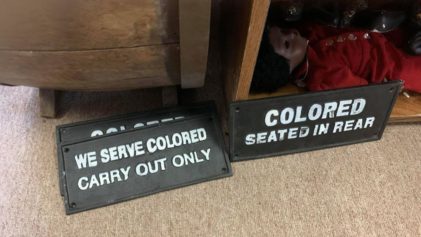This is Part 1 of a three-part story on the everyday experiences of racial violence, loss of land, rape and trauma that African Americans endured during the Jim Crow era (1896-1960’s). The second part of the story will focus on the violent history of the rapes of African American women and children during Jim Crow and the long term collective psychological consequences, segregation stress syndrome. The third part of the story will focus on the historical rape of Ruby McCollum. You will hear Ruby McCollum share her story of rape, murder, and the trial that put her in a mental institution for 20-years.
By: Dr. Ruth Thompson-Miller
Jim Crow: Racial Violence and Loss of Land
Historically, as a society, we learn that the era of Jim Crow included Rosa Parks sitting on a bus and getting arrested, Dr. Martin Luther King and his “I Have a Dream” speech and the assassination of the outspoken Malcolm X. Indeed, these are important events, but we are not given the historical truth that explains why Black men, women and children were willing to be sprayed by water hoses, bitten by dogs and beaten to near death in the streets of this country. The historical facts are that the system of Jim Crow in the South was more similar to the system of slavery than many of us knew with the exclusion of the chains.
According to Sociologist Joe Feagin in the book Systemic Racism, “today as in the past systemic racism encompasses a broad range of white-racist dimensions, the racist ideology, attitudes, emotions, habits, actions, and institutions of whites in this society. Systemic racism is the foundation of this country (created by powerful white men) and has been utilized to exploit, oppress, and control the bodies of African-American men and women. The hierarchy consists of whites on top and blacks on the bottom.
In his book Racist America, Feagin asserts,
“It is a comprehensive system of exploitation and oppression originally designed by white Americans for black Americans, a system of racism that for centuries has penetrated every major area of American society and thus shaped the lives of every American, black and non-black … White on black oppression extended well beyond the economy. It destroyed cultures, families, and heritage.” (pg. 204-5)
The oppression of African-Americans in this country started with the kidnapping of Africans from their homeland and has been on a continuum since the first enslaved African set foot on American soil in 1619. One of the many tragedies that resulted from over 400 years of oppression is the enormous land that was lost or stolen from African-Americans through racial violence.
Racial Violence and Loss of Land
The land lost contributes to an inability to maintain wealth (in the form of land and home ownership). According to Elliott Jaspin, in his book Buried in the Bitter Waters, there are many counties in the U.S. where racial cleansing occurred, Jaspin asserts,
“History is what we choose to remember. … The racial cleansing that struck Forsyth County, Georgia in 1912, for example engulfed at least a half dozen surrounding counties in northern Georgia before it burned itself out in 1913 … More than a thousand people — 97 percent of the county’s black population — were driven out over a period of about two months. They owned 1,900 acres of farmland, nearly all of which they were forced to sell and abandoned. The county’s five black churches were burned. … Racial cleansings occurred across the nation. They occurred in the North and Midwest as well as the South.” (pg. 4-5)
Indeed, the documentary on the small town of Rosewood in Florida is just one example of racial expulsion. In Ebony Black History’s “The Burning of Black Wall Street,”
According to Josie Pickens wrote, “in Greenwood, Oklahoma, a suburb of Tulsa. … in 1921 300 African Americans lost their lives and more than 9,000 were left homeless … Tragically, it was also one of the bloodiest and (most) horrendous race riots and acts of terrorism that the United States has ever experienced.”
According to David Bryant, a citizen of Wilmington, North Carolina during the Race Riots. An article, Thousands Gone, published in the Semi-Weekly Messenger in 1899, Bryant states, “ . . .since the race trouble last November, and he says he was brought to realize that they (Blacks) had left here (Wilmington, NC) by the thousands.” Reportedly, African Americans lost their business, jobs, homes, and lives as they fled white mobs.
Unjust Impoverishment: Loss of Land
In the era of Jim Crow, African-Americans didn’t have the right to protect their women, children and family members against white intruders. The terrorism and trauma that women and men experienced during Jim Crow was a daily event. You didn’t have to witness racial violence in order to be traumatized by the incident. According to Joe Feagin in his book Systemic Racism and Elliot Jaspin in his book Buried in the Bitter Waters, the historical prevalence of institutional discrimination (in housing, employment and other institutions) and systemic racism have contributed to contemporary unequal wealth accumulation and wealth distribution in this country and has created unjust enrichment for the dominant group and unjust impoverishment for people of color in Jim Crow.
In the book, Jim Crow’s Legacy respondents discussed their families stolen land. Wealth in homeownership and land is one of the defining factors that can determine a family’s ability to send their children to school, to assist children with purchasing their own homes, and to weather bad economic times. However, in the Jim Crow south the data on the enormous acres of land that was stolen from African Americans has yet to be calculated. The lost of land has had an impact on the economic insecurity of African American families today and has created unjust impoverishment.
“My grandfather owned a lot of land down there. My grandfather was one of the, if we could call it, one of the important blacks down there. He had over 500 acres of land. He had his own farm. He had people who worked for him. I’ve never known a hungry day in my life. There are other people that might have. We were poor; I don’t mean that we had of money. But we had, we lived on the farm with my grandfather that had the resources, and he wasn’t an educated man. He was just a man that had common sense, good mother wit, and know-how to do things. But I’ve never known a hungry day in my life.”
“My father never did tell us about it, the land. But when he was dying he told us how whites stole his land. They forced him to sign papers that gave them control of the land. They threatened him, and he was afraid and didn’t know what to do. Before he died he begged me to see if I could get the land back for the family. I’m not sure what to do.”
The wealth, or opportunity for wealth generating resources, was thus lost to the family, apparently under discriminatory pressures from whites. Today some members of the African American community have the deeds to their land and are still fighting to get it back.
Dr. Ruth Thompson-Miller is assistant professor of sociology at the University of Dayton. Her research specializations are race and ethnicity, mental illness, and the elderly. She received the American Sociological Association (ASA)-National Institute of Mental Health-Minority Fellowship Award (3 years). She co-authored the book, Jim Crow’s Legacy: The Lasting Impact of Segregation (Rowman and Littlefield, 2015). She has several and book chapters including in the Counseling Psychology, Sociology of Racial and Ethnic Relations, and Violence Against Women and appears in the a documentary about Ruby McCollum story, “You Belong to Me: Sex, Race, and Murder in the South.



